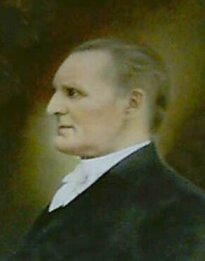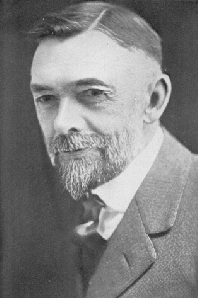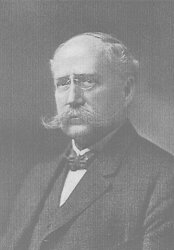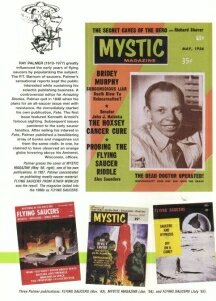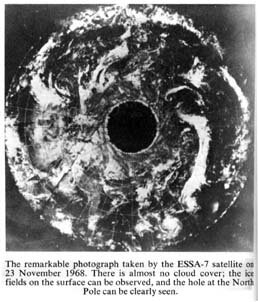Meet the players.
While researching a subject one collects much more information than needed to tell the story. But some of that is fascinating in itself. I always like to know something about the players in the story of the Tamarack Mines mystery, so I've collected pictures and short biographies of the people involved in it.
|
Cyrus Reed Teed (1839-1906) was born in New York. He was a doctor of Eclectic Medicine who also dabbled in Alchemy and Astrology. Teed received an "illumination" in which the female half of the godhead revealed to him how the universe was really constructed, and told him to bring this knowledge to the world. This universe was an inside-out version of the commonly accepted model. It had the entire universe enclosed in a hollow cell in rock. We live and walk on the inside of this shell, and the entire universe is inside, but much of that is an illusion formed from the interaction of gravic, levic and light rays. Light rays travel with a speed that depends on their distance from the center, and refract greatly, to produce the illusion of moon, planets, and stars. Teed called this the "cellular cosmogony", and likened this cell within rock to the hands of God cradling his creation. At that time Teed was a member of a shaker community, but within a year he formed his own community, taking the name "Koresh", the Hebrew version of "Cyrus". His "Koreshan Unity" was based on communal ownership of property, celibacy as an ideal, and of course, the "cellular cosmogony" This small community moved to New York City, then to Chicago. They did not feel welcome in any of these places. Finally they settled on donated land in Florida, where Teed hoped to build his "New Jerusalem". His community was now called the "Koreshan Unity".
Teed's death in 1906 was a shock to what remained of the Koreshan community. It may have resulted from injuries received previously while he was trying to break up a brawl between residents of Fort Myers and some Koreshans. Teed had made enigmatic statements that his followers interpreted as indicating he might arise from the dead, so they did not bury his body. But after a few days, the county health officer ordered that they do so. His corpse was placed in a stone vault near the Estero river, with a boat nearby for his convenience if he should arise from the dead. Several years later the vault was destroyed by a storm and his remains were never found.
|
Ulysses Grant Morrow (1864-1950). Morrow was born in Kentucky. He taught business and shorthand courses at a school in Corning, Iowa. While there he published a book on "Phonography", his system of phonetic shorthand. He edited small newspapers, including "The Plowshare and the Pruning-Hook" and "The Salvator and the Scientist". He converted from "Eclectic Philosophy" to Koreshanity in 1895 and edited their newspaper, "The Flaming Sword".
Morrow called himself a "geodesist". He was said to be very well read, a good writer and a poet and had a good sense of humor. He also had a reputation as a clever inventor of useful machines.
In 1897 Teed, wanting concrete experimental evidence of his hollow earth model, asked Morrow to carry out measurements of the water surface near Naples, Florida. Morrow invented a "rectilineator", a 12 foot long structure of mahogany and brass with which one could establish a straight "physical" line over long distances. It would allow measurement of the curvature of water with respect to the physical line, over a four-mile stretch of shoreline. This experiment, called the "Naples geodetic survey" was carried out over several months time, and according the Morrow team's careful measurements, seemed to show that the earth curved upwards, as Teed and Morrow expected. The error made in this Naples experiment was a simple but subtle determinate error that propagated badly.
Morrow wrote the greater part of Teed's 1897 book The Cellular Cosmogony. In 1905 Morrow left the Koreshan settlement after a serious disagreement with Teed. He continued to promote and develop the hollow earth idea, being in contact with groups in Argentina and Germany who also believed it. Editions of The Cellular Cosmogony after 1905 drop all mention of Morrow, but continued to use large sections of what he wrote. Morrow worked as a typesetter at a newspaper in New Orleans till his death in 1950.
Little survives related to Morrow. His own family saved hardly anything of his writings and correspondence, and seldom talked of him, considering his conversion to Koreshanity something of a disgrace to the family. In the Koreshan community, Teed was the "celebrity" and Morrow's substantial contributions received little recognition. Modern authors and historians are more interested in the social and historical impact of the Koreshan community, and treat Teed's cosmogony as a curious side issue (even though Teed considered it the heart of his philosophy). Morrow hardly rates a footnote in their accounts.
|
Fred W. McNair (1862-1924) was born in Fenimore, Wisconsin. He received a B.S. degree from the University of Wisconsin in 1991, and then did graduate work at the University of Chicago in 1892-93.
McNair was instructor of mathematics at the University of Wisconsin from 1889 to 1891, and then took a position as assistant professor of mathematics at Michigan Agricultural College. He was appointed professor of mathematics and physics at the Michigan College of Mines (now Michigan Technological University). He received the Doctor of Science degree from Lafayette College in 1907, and also from Rhode Island State College in 1919.
During World War I McNair provided the College facilities for the training of engineers for the army, and was also involved (with Dr. J. F. Haford of Northwestern University and R. L. J. Briggs of the Bureau of Standards) in developing methods for firing large naval guns.
During 1901-1903 he conducted an ambitious experiment at the Tamerack Mines for the purpose of determining the variation of the earth's crustal density by measuring the acceleration due to gravity at different depths in deep mine shafts. The measurements were done in cooperation with the U. S. Geodetic Survey, using precision pendulums and chronometers. These were the most accurate determinations ever made of the variations in gravitational field strength within the crust of the earth.
McNair served as president of the Michigan College of mines for about 25 years. He was recognized for his efforts in strengthening the quality of engineering education.
|
William Hallock (1857-1913) was born in Milton on the Hudson. He graduated from Columbia College in 1879, and then spent three years on a Fellowship in Würzburg, where he received the Ph.D. in physics in 1881. He returned to work as a physicist for the U. S. Geological Survey studying physics of rocks and geological processes. Transferred to the National Museum in Washington, he worked there from 1883 to 1891. In 1892 he was put in charge of the astrophysical laboratory of the Smithsonian institution, under Professor Langley. In Washington he began a teaching career as professor of physics in the Corcoran Scientific School (1884-86) and as professor of chemistry and toxicology in the National College of Pharmacy (1889-92), an institution that granted him the honorary degree of doctor of pharmacy in 1892. From 1892 to 1902 he served as professor of physics on the faculty of Columbia University, served as Dean of the faculty of pure science from 1906 to 1909 and continued to serve as administrator of the physics department.
His interests were wide-ranging, including geology, championing the metric system, studies of geysers (in Yellowstone), physics of lightning, physics of sound and speech (he wrote the chapter on Sound in Duff's physics textbook), and even nautical matters (he was an avid yachtsman).
|
Ray Palmer (1910-1977) started the flying saucer craze (business?) in 1947 when he published sensational reports of the Adamski UFO sightings. He was at that time editor of science fiction magazines. Later he retired to his Wisconsin farm to churn out magazines like Flying Saucers and Mystic. In his later years he was somewhat of an enigma and a recluse.
|
Palmer had published articles supporting the earth-cell inside-out universe (1960). But by 1970 he was championing the earlier (and incompatible) view of an earth much like the conventional picture, but hollow, with an opening at the North Pole.
In the June 1970 issue of his Flying Saucers magazine Palmer proclaims that earth satellite photos had at last proved the existence of the North Polar hole, while the South pole photos show no hole. Palmer gleefully gloats that this should at last silence his critics.
|
Of course the dark area at the pole is easily explained. This picture Palmer used was taken Nov. 23, 1968, in visible light, and was a mosaic of the 13 daily orbits' vidicon camera records. In November the North Polar region is dark all day, so imagery there is suppressed by the system's programming.
Well over a million other photos, taken at other times of the year, clearly show a cloud-covered pole. Newer satellites photograph in both visible and infrared, and can show detail even in dark areas.
It seems incredible that Ray Palmer could have taken this seriously even then. Many suspect that he didn't, that he was perpetrating a great put-on. It's fun to look for the answer by examining his writings, and the few interviews he gave. We can't ask his opinion now, for he died in 1977.
In that 1970 issue of his Flying Saucers magazine, the one proclaiming proof of the Polar hole, we also find an article debunking the hollow earth idea! This piece is credited to John M. Prytz, an unlikely sounding name. No address or affiliation is given for Mr. Prytz, while such information is given for other contributors. I suspect that Prytz is another one of Palmer's many pseudonyms, and he was having a big laugh at the whole gullible world as he argued both sides of the issue.
Those who cite Palmer's 1960 article as supportive of the cellular cosmogony should take a larger look at Palmer's entire output and realize that he is not a reliable source for anything. Furthermore, he didn't care.
